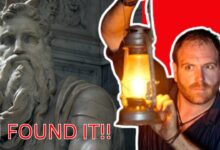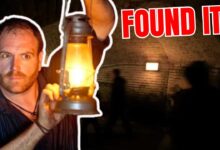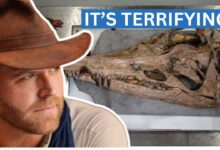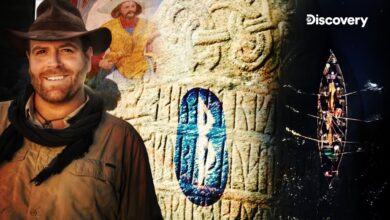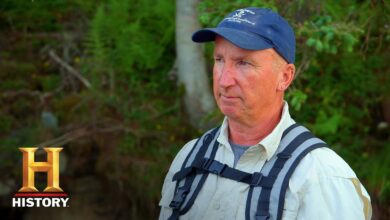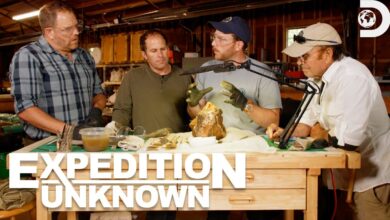Lost Civilization Uncovered! Josh Gates Explores Etruscan Ruins | Expedition Unknown
Lost Civilization Uncovered! Josh Gates Explores Etruscan Ruins | Expedition Unknown

Foreign: Look at this thing! This is what’s known as a tumulus. A tumulus—it’s a tomb cut into the summit of a hill, literally cut into the top of the hill.
[Music]
Josh: Right. So, you have to imagine this being kind of the main tomb area of a whole family, and there are tombs carved in all along the outside of this tumulus. And then there’s one of the biggest, the principal tomb, which would have been maybe for the founder of a dynasty, or definitely the leader of that family group.
Foreign: Wow. Can we see it?
Josh: Yeah, let’s go. I mean, look at this place. This is serious construction. It’s cut out of the hill, a big passageway leading into the main tomb. But you can see here how it’s carved into the summit of the hillside, and then blocks are used to build up the top and make an even more impressive entryway. This is definitely like the big boss’s tomb. The big boss in the middle of the 7th century BC was buried right in here.
Foreign: And what’s going on inside?
Josh: Let’s go see. The painted chambers we saw back in Tarquinia aren’t the only type of Etruscan tomb. Here, we see them carving what life may have been like in three dimensions. Now this is legit. Look at this, carved columns. This is like very regal. Back in the day, these huge family tombs must have looked so impressive.
Foreign: I think they would have been magnificent, crowning the hilltops of the necropolis on all the hills surrounding the city of the living.
Josh: Absolutely. Unbelievable. One such hilltop still exists, a nearby Etruscan necropolis called Ceter, has stone made to look like wood beams, benches, long hallways, and detailed reliefs. There’s even a carving of a book on a night table, evidence that the Etruscans once had literature.
Foreign: But those tombs, like the ones I saw at Tarquinia and even this one here, had been largely raided.
Josh: When this tomb was discovered, it had been looted.
Foreign: It had been looted. We have some objects and some sculptures from inside. For instance, there were two griffins guarding the entrance. This gives you an idea of how important the individual was.
Josh: This really is a tomb fit for a king. Very high status.
Foreign: Yeah, David is determined to find undisturbed burials here at this site, which may contain inscriptions that could unlock the Etruscan language, as well as priceless grave goods to explain their culture and origins.
Josh: But as it turns out, even some of the tombs that have been broken into aren’t totally empty. Right under our feet is an old funerary path that leads along the side of a row of tombs.
Foreign: There’s one here… and there’s another one here.
Josh: Oh, wow. Look at this! I mean, I would never have seen this. Just totally filled up and overgrown. This is a good example of what the tombs look like when we first encountered them.
Foreign: So why isn’t this fully covered?
Josh: Because at some point in the past, somebody broke into this tomb by removing the top block of the doorway. So, it’s been looted.
Foreign: Has it been excavated?
Josh: It has not been excavated. But typically, the looters leave a wealth of information inside the tomb for us to document.
Foreign: Okay. Do you want to go in?
Josh: No, there’s signs in there.
Foreign: No, there’s spiders in there, dude. Spiders and signs.
Josh: Yeah, but a lot of spiders. Let’s go.
Foreign: You’re going first, though.
Josh: Alright, spiders or not, we’re going in.
Foreign: Alright, here we go.
[Music]
Josh: This is horrible.
Foreign: Okay, I’m in. Wow, this is awesome in here, actually.
Josh: Okay, so we’ve got two beds here with these kind of lower bunks carved out here.
Foreign: That’s right, there’s room for two on each side here to be laid out. Each tomb has its own particularities.
Josh: Alright, well let’s have a look around.
Foreign: Yeah.
Josh: Oh, wow! Josh, look over here! What do you have?
Foreign: There’s just bone everywhere here, just littered all over this bed. All these little white flakes that we see here, this big piece—that’s all human bone.
Josh: That’s right. These remains weren’t deliberately damaged. Chances are, the ancient brittle bones shattered as the tomb was being looted.
Foreign: What is that? That dark thing?
Josh: This is a piece of bronze. Wow! Look at that!
Foreign: What do you think this is from?
Josh: I think it would have been a decorative element, perhaps something they were wearing.
Foreign: Yeah, probably a breastplate, maybe part of a belt. These people would have been laid out here wearing their best.
Josh: Right. They would have been laid to rest in their finest clothes.
Foreign: Look at that. Is that a tooth? A molar?
Josh: Oh my word, that is a tooth! That is a human tooth. That is an Etruscan tooth right there!
Foreign: Not just a trace of pottery now, not just the trace of their architecture, but actually the remains of an individual.
Josh: That’s right. And this is important data. We can do a series of analyses on bones like this that’ll tell us about the life and the diet, the health, the migrations, and the origins of the Etruscans.
Foreign: This is a big question—their origins, right?
Josh: Right. Because they do seem to us to be this culture that just kind of comes out of nowhere, and people have been debating their origins since ancient times.
Foreign: Right. From their writings, the Roman writers and Greeks looked at the Etruscans as an exotic culture that could not have been from the Italian Peninsula. The Roman writer Livy speculated they were from Turkey, home of the mighty Trojans. Others thought they were originally from Greece. But because the Etruscan language hasn’t survived, they’ve never been able to speak for themselves.
Josh: Recently, there’s been an increasing number of genetic studies, both using modern populations and ancient populations.
Foreign: Okay, and those studies may show us where the Etruscans were really from.
Josh: Recently, scientists gathered genetic information from the ancient remains of 82 Etruscans to compare the DNA against other ancient and modern peoples.
Foreign: Okay, so where are they really from?
Josh: Here, on the Italian Peninsula, in the middle of Italy.
Foreign: So they’re not from somewhere else at all?
Josh: It doesn’t seem that way. So they’re just part of this landscape—literally, they’re from here.
Foreign: They’re Italians.
Josh: They’re Italians! They’re from here.
Foreign: Identifying the origins of the Etruscans is a major win. But even with these human remains, we’re left with more questions than answers. Right here in front of us, we have, in many pieces, an Etruscan individual. I don’t think the story is fully told.
Josh: In order to fully know who the Etruscans were and why they fell to Rome, archaeologists need unlooted tombs. But every burial David’s team has found to date has been robbed. And the tombs are hard to locate since they’re overgrown, buried, or hidden along steep cliffs. In other words, we need some high-tech help.
Foreign: Josh, this is Forest, Laura, and Natalie from LAR USA.
Josh: I’m very familiar with LAR USA. I’ve worked with your company before.
Foreign: Yes, you have. You worked with our dad Jeff in Roanoke.
Josh: That’s right. And my brother Daniel in Guatemala.
Foreign: Yes, at Alador. I think I made your brother throw up in a helicopter.
Josh: Sometimes science is… pukey.
Foreign: He’s okay now. He’s fine. He’s recovered.
Josh: Okay, sorry about that.
Foreign: Sorry. And here we are again. Yes, so okay, talk to me. What’s the plan here?
Josh: I’m excited about this because this is, as you’ve seen, a very hard site. Very challenging to actually see what’s on the surface. Lot of hills, lot of vegetation.
Foreign: That’s right. The LiDAR will get us through those trees, right?
Josh: The plan is for the LiDAR to peer down
